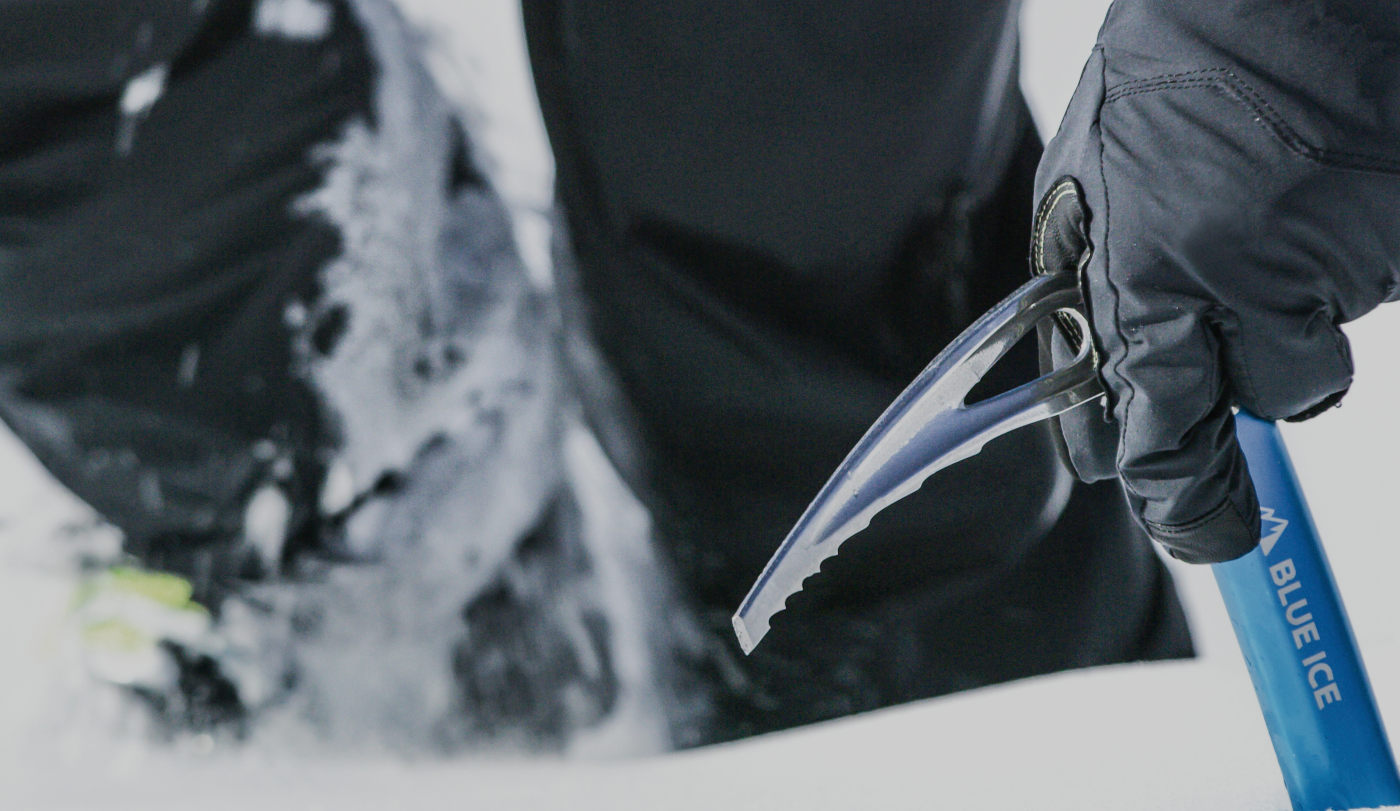By Morgan Cvetkovic-Jones
Our fleeting dalliances with cold snaps and snow often send the country into meltdown. However, for some of us, these days of high pressure, crisp air and the white stuff are pretty magical. The urge to play in the snow is irresistible but knowing how to embody this spirit in the mountains can seem a bit of a minefield of kit, cold and couloirs. Along with suitable footwear and crampons a walking/mountaineering axe is an essential piece of kit to carry. As such we’ve put together this succinct buying guide to mountaineering axes:
Difference between a walking and climbing axe?
Although some mountaineering axes have basic climbing capabilities and ratings, generally they are not designed as outright climbing tools. The lighter, more simplistic (one-piece) construction combined with a generally longer, straighter shaft makes them better suited to snow-covered slopes (upto ~55 degrees) and gullies along with glacier travel. Rather than tackling overhanging ice and being almost permanently loaded with weight, these axes are designed as a steadying tool and safety aide whilst walking or skiing; with the spike at the base of the shaft being plunged into the snow to give you stability (much like a trekking pole), while the ‘pick’ is primarily there for self-arrest (if you fall over) and the ‘adze’ to cut steps or platforms if required. The hole on the head is for a leash or use with a carabiner when the axe is being used as a belay anchor, while the hole in the spike is another attachment option for a leash.
The Right Axe for You
Mountaineering axes come in a multitude of different lengths, shapes and materials. Finding the right size and design for you can be overwhelming but here’s a sizing guide followed by a breakdown of features to help you choose.
Length – Most mountaineering axes come in increments of 5cm, usually ranging from 50cm-70cm, although smaller and longer sizes are available.
How to Size your Axe
- The gold standard for choosing the right size for you is that the base spike should hover at or just above your ankle (~2cm).
- Be sure you’re standing up, facing forward in a relaxed yet upright position with the axe down by your side.
- Have the axe head in your palm with the adze forward and your thumb resting on it.
- For those regularly tackling particularly steep terrain, a shorter shaft would be recommended so as not to put you off balance - pushing you backwards when digging the shaft into the snow.
- Below the ankle is too long.
- To measure this at home, hold a tape measure in your hand (positioning yourself as described above) and ask someone else to pull the tape down to the correct point to establish the length you will require.
Longer Ice Axe?
You will notice many manufacturers offer very long axes, which no one would size themselves with using the aforementioned method. You might consider these if you intend to predominantly use it to probe for cornices and crevasses, build anchors or to regularly travel on low-angle/flat snowfields. Generally we would not recommend an overly long axe due to the difficulty in actioning self arrest - its main safety function.

Curvature
Either straight or slightly bent (sometimes referred to as hybrid axes), the profile of a mountaineering axe shaft will depend largely on the technicality of your terrain. Straight handles are designed for a shallower topography where the majority of the axe’s job will be to steady you whilst you walk, modify terrain and be on hand for an emergency self-arrest. Those with a slight curve are designed for exactly the same purpose but incorporate the bend to avoid your hand hitting the snow when driving the pick into a more precipitous slope. Axes with a curved shaft are often (not always) hybrid axes, with higher strength ratings and offering the option to be used as a pair on steeper ground if desired.
Materials
The material make-up of your axe will vary upon your intended activity and how much cash you have to spend. Generally speaking, the pick and spike of an axe is made from a steel alloy which perfectly balances low weight and the stoic durability required from the business ends of the axe. For the shaft, aluminium or a similar alloy is usually the choice material, again providing the optimal weight/endurance blend; cheaper axes may come with a steel handle which is slightly heavier. The odd titanium axe does exist but these are expensive and uncommon.
CEN Rating
Whilst perusing the finer technical details of ice axes, you will have undoubtedly encountered CEN-B/T ratings for the pick and handle. It is worth noting, some companies (DMM for example) now use an updated version of this known as Type 1 (equivalent of B- rating) or Type 2 (equivalent of T-rating). This certification essentially denotes the strength of the shaft; with B (Type 1) standing for basic and T (Type 2) standing for technical. Most mountaineering axes come with B ratings meaning they are lighter, cheaper and definitely not designed for belaying or mixed ice climbing – yet perfect for their intended uses of winter hiking, ski touring, glacier walking.
Some will come with a T-rating (particularly hybrid axes) denoting their technical status, these axes are normally more substantial and designed to offer the option of being used as a pair on more technical ground if required. Contrary to this you can combine a B-rated axe with a T-rated pick and it will be strong enough for pure water ice climbing only.

To leash or not to leash?
Leashes, while not essential, are used by most with walking/mountain axes - you would not want to lose your new axe down that 500m slope you just ascended! They come included with many axes but if not they can be purchased separately. Alternatively, you can also make your own leash from either 5mm to 7mm accessory cord or 2.5cm webbing, using a lasso and overhand knot.
















